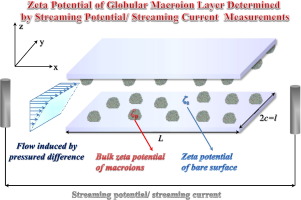Advances in Colloid and Interface Science ( IF 15.6 ) Pub Date : 2017-09-29 , DOI: 10.1016/j.cis.2017.09.004 Aneta Michna

|
Recent studies on macroion adsorption at solid/liquid interfaces evaluated by electrokinetic and optical methods are reviewed. In the first section a description of electrokinetic phenomena at a solid surface is briefly outlined. Various methods for determining both static and dynamic properties of the electrical double layer, such as the appropriate location of the slip plane, are presented. Theoretical approaches are discussed concerning quantitative interpretation of streaming potential/current measurements of homogeneous macroscopic interfaces. Experimental results are presented, involving electrokinetic characteristics of bare surfaces, such as mica, silicon, glass etc. obtained from various types of electrokinetic cells. The surface conductivity effect on zeta potential is underlined. In the next section, various theoretical approaches, proposed to determine a distribution of electrostatic potential and flow distribution within macroion layers, are presented. Accordingly, the influence of the uniform as well as non-uniform distribution of charges within macroion layer, the dissociation degree, and the surface conductance on electrokinetic parameters are discussed. The principles, the advantages and limits of optical techniques as well as AFM are briefly outlined in Section 4. The last section is devoted to the discussion of experimental data obtained by streaming potential/current measurements and optical methods, such as reflectometry, ellipsometry, surface plasmon resonance (SPR), optical waveguide lightmode spectroscopy (OWLS), colloid enhancement, and fluorescence technique, for mono- and multilayers of macroions. Results of polycations (PEI, PAMAM dendrimers, PAH, PDADMAC) and polyanions (PAA, PSS) adsorption on mica, silicon, gold, and PTFE are quantitatively interpreted in terms of theoretical approaches postulating the three dimensional charge distribution or the random sequential adsorption model (RSA). Macroion bilayer formation, experimentally examined by streaming current measurements, and theoretically interpreted in terms of the comprehensive formalism is also reviewed. The utility of electrokinetic measurements, combined with optical methods, for a precise, in situ characteristics of macroion mono- and multilayer formation at solid/liquid interfaces is pointed out.
中文翻译:

Macroion吸附—电动和光学方法
综述了通过电动和光学方法评估的在固体/液体界面上的大分子离子吸附的最新研究。在第一部分中,简要概述了在固体表面上的电动现象。提出了用于确定电气双层的静态和动态特性的各种方法,例如,滑动面的适当位置。讨论了有关均质宏观界面的流电势/电流测量结果的定量解释的理论方法。提出了实验结果,涉及从各种类型的电动细胞获得的裸露表面(如云母,硅,玻璃等)的电动特性。用下划线标出了表面电导率对ζ电势的影响。在下一部分中,各种理论方法 提出了用于确定静电势的分布和大分子层内的流量分布的建议。因此,讨论了在大分子离子层内电荷的均匀和不均匀分布,解离度和表面电导对电动参数的影响。第4节简要概述了光学技术以及AFM的原理,优点和局限性。最后一部分专门讨论通过流电势/电流测量和光学方法(例如反射法,椭圆法,表面法)获得的实验数据。等离子共振(SPR),光波导光模光谱(OWLS),胶体增强和荧光技术,适用于单分子和多层大分子。聚阳离子的结果(PEI,PAMAM树状聚合物,PAH,PDADMAC)和聚阴离子(PAA,PSS)在云母,硅,金和PTFE上的吸附是根据理论方法定量解释的,该方法假定三维电荷分布或随机顺序吸附模型(RSA)。还审查了宏观离子双层的形成,通过流式电流测量进行了实验检查,并从理论上对综合形式主义进行了解释。指出了电动测量与光学方法相结合的实用性,可用于在固/液界面精确,原位形成大分子离子单层和多层。还审查了宏观离子双层的形成,通过流式电流测量进行了实验检查,并从理论上对综合形式主义进行了解释。指出了电动测量与光学方法相结合的实用性,可用于在固/液界面精确,原位形成大分子离子单层和多层。还审查了宏观离子双层的形成,通过流式电流测量进行了实验检查,并从理论上对综合形式主义进行了解释。指出了电动测量与光学方法相结合的实用性,可用于在固/液界面精确,原位形成大分子离子单层和多层。



























 京公网安备 11010802027423号
京公网安备 11010802027423号